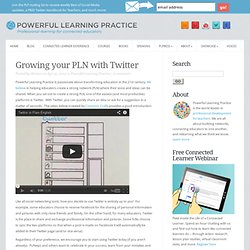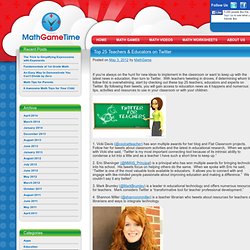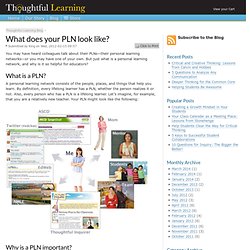

10 Things You Can (And Should) Do On LinkedIn. As LinkedIn’s user base continues to climb (currently 160+ million members), you have more and more opportunities to connect with colleagues, clients and prospects, not to mention establish your industry expertise and pursue new business development initiatives.

And although LinkedIn is simple enough to use, what’s truly fascinating about the site is that it offers a wide range of functionality if you take a moment to dig beneath the surface. The good news? We’ve done the heavy lifting for you and have compiled a tip list of 10 things you should be doing on LinkedIn to get more leverage out of this professional networking site. Expand your search. As with any social site, one of the key components of LinkedIn is conversation. Optimize your URL. Growing your PLN with Twitter. Powerful Learning Practice is passionate about transforming education in the 21st century.

We believe in helping educators create a strong network (PLN) where their voice and ideas can be shared. When you set out to create a strong PLN, one of the easiest (and most productive) platforms is Twitter. With Twitter, you can quickly share an idea or ask for a suggestion in a matter of seconds. The video below (created by Common Craft) provides a good introduction: Like all social networking tools, how you decide to use Twitter is entirely up to you! Regardless of your preference, we encourage you to start using Twitter today (if you aren’t already). To help you leverage your 140 characters and make the most of your time, here are a few tips and tricks: 1. Usernames can be changed (w/o loss of data,) but it’s better to stick with one from the beginning so you don’t confuse your followers.If you choose something short, it will make it easier for others to retweet your posts. 2. 3.
Top 25 Teachers & Educators on Twitter. If you’re always on the hunt for new ideas to implement in the classroom or want to keep up with the latest news in education, then turn to Twitter.

With teachers tweeting in droves, if determining whom to follow first is overwhelming, start by checking out these top 25 teachers, educators and experts on Twitter. By following their tweets, you will gain access to education news as it happens and numerous tips, activities and resources to use in your classroom or with your children. 1. Vicki Davis (@coolcatteacher) has won multiple awards for her blog and Flat Classroom projects. Follow her for tweets about classroom activities and the latest in educational research.
Connected Learning Infographic. Thoughtful Learning: Curriculum for 21st Century Skills, Inquiry, Project-based Learning, and Problem-based Learning. You may have heard colleagues talk about their PLNs—their personal learning networks—or you may have one of your own.

But just what is a personal learning network, and why is it so helpful for educators? What is a PLN? A personal learning network consists of the people, places, and things that help you learn. By definition, every lifelong learner has a PLN, whether the person realizes it or not. Also, every person who has a PLN is a lifelong learner. Why is a PLN important? Having an active personal learning network is important for a number of reasons: Lifelong learning: A PLN helps you learn and grow. How can I develop a PLN? Start with what you have. Then look for gaps. Invite others along. 6 Quick Ways Teachers Can Be Hip. If you’re a teacher and a reader of Edudemic, you’re a hip cat. But what about those teachers and other educators who DON’T read Edudemic? Believe it or not, there are some out there. This post is for them. In an effort to keep all teachers pursuing the best possible ways to integrate education and technology, we thought it might be good to take another look at ways teachers can be hip.
By ‘hip’ I simply mean that a teacher is aware of trends and actively engaging to stay on top of what his or her students need. 1. Twitter is the de facto place for education professionals and students to easily meet, interact, and exchange ideas online. For example, you may have been excited to teach your students about why the sky is blue and your fellow tweeting teachers may point out that Gizmodo recently posted about this very topic and they have a concise description of why the sky is blue.
Did you notice those hashtags at the end of that example tweet?